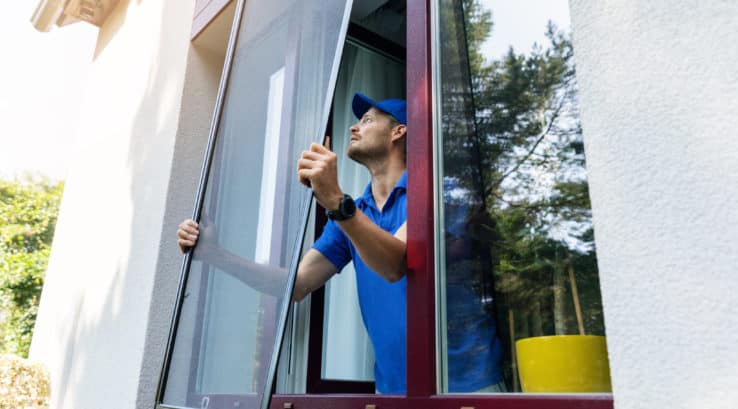Window screens are the gatekeepers of our homes. They work hard to prevent animals and debris from hanging out in our kitchens. They also allow fresh air and the sweet smell of fresh-cut grass to weave their way inside. It’s a win-win — but what happens when we start taking them for granted?
Knowing when to replace window screens (and how to repair them in between) is an invaluable skill. Learn how to take care of these low-maintenance assets and they’ll take care of you.
How Do I Know When to Replace Window Screens?
Before you can understand when to replace window screens, you must understand why it’s necessary. Screens are made to be durable, but that doesn’t mean they’ll last forever.
Here are a few things that could affect your screens’ lifespans:
- Materials: Screens are most often made of steel, aluminum, or fiberglass. The softer the material, the shorter its life expectancy.
- Construction: Frames are typically made of steel or aluminum. While steel may seem stronger, aluminum is great at withstanding the sun, rot, and rust. Whether the frames’ joints are plastic or mitered influences durability, too.
- Care: Screens that are handled or removed frequently could be more prone to damage.
- Exposure to the Elements: Continuous exposure to water from rain or sprinklers isn’t ideal. Neither is constant battering from hard winds, the sun, or other extreme weather conditions.
So, answering “when to replace window screens” really depends on the screen. One that’s well-maintained and in a spot sheltered from the elements could last 10 to 15 years. A screen that’s handled poorly or built using subpar materials could need to be replaced a lot sooner.
When to Replace Screen for Windows: 5 Signs It’s Time
Keep an eye out for these signs that could suggest it’s time to go screen shopping:
- Visible Damage on the Screen: Ripped screens, bent frames, and other visible damage is unsightly and could also cause larger problems. Preserve your home’s security and curb appeal by replacing broken screens as soon as possible.
- Stuck Screens and/or Windows: When screens become warped by the sun, rain, or wind, they become hard to open. That makes it difficult to enjoy fresh air or tease the neighbors with the smell of your freshly baked pie.
- Finding Bugs Inside the Home: Even if you can’t see a warped screen frame or rip, you may spot bugs coming in through the window or congregating on the floor below. Examine the screen closely to see if those critters are somehow gaining access through a tiny separation or tear.
- Shiny Screens: The more a screen is subjected to wear and tear, the shinier the metal will get. A glossy screen is likely wearing down and in need of replacement.
Screen Maintenance Tips
If you’re interested in replacing your screens less often, invest in a good brand and focus on maintenance.
The most important thing is regular cleanings. Wipe the window track to remove water, dirt, and debris. You can also use this time to do a quick inspection for any corrosion or other worrisome blemishes. Check the corners, too; if they’re separating or warping, it’s time to look at some energy-efficient replacements.
As for the screening material itself, the biggest concerns are tears. Some holes can be patched to extend the life of the screen. A sagging screen or one that has a large rip may not be salvageable.
Finally, start removing your screens for winter. You’ll likely want to slip in storm windows for extra insulation anyway. Removing the screen will also help prevent snow buildup on the windowsill that could cause rust or rot.
Now that you know when to replace screen for windows, it’s time to take a tour of your house and see where your screens stand. If you think you’re ready for an upgrade, give your home the windows it deserves courtesy of Thompson Creek. For more information on our superior replacement windows and expert installation, check out our service areas.


